Ed. note: This piece was originally published in Spanish here in Ladera Sur.
Regardless of whether or not one belongs to a First Nation, more and more people and communities are seeking to resume a good life, that is, to achieve common and personal well-being in coexistence with our living planet. Throughout history, and now more than ever, learning from First Nations and the traditional knowledge they offer may be the key to our resilience as living beings “to survive well together” in the Anthropocene (Gibson-Graham et al. al., 2013).
Ed. Note: The international community created the “blue” label to promote sustainable livelihoods in the seas and coastal areas.
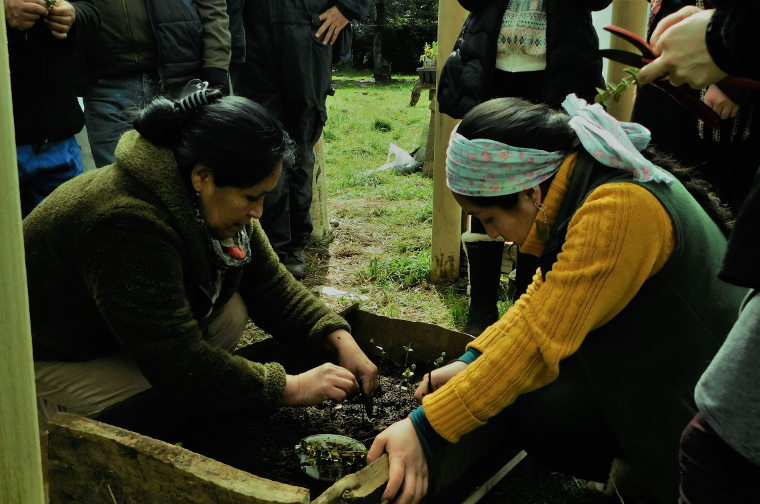
© Budi Anumka. Used with permission
In various regions of the world, despite the challenges posed by the growing fragmentation of both knowledge and institutional structures, as well as biocultural landscapes and their ecosystems, indigenous peoples and their allies are using global tools (institutional, technological, communicational) to reaffirm their own deeply relational worlds or territories of life. With this reaffirmation comes the possibility of “buen vivir” (good living) with economic, environmental, cultural, and spiritual dimensions in healthy balance.
Regenerative community economies, built by the communities themselves to restore their territories, heritage, livelihoods and, ultimately, their good living, are now more urgent than ever. Responses structured organically from the bottom up are slow to take shape during the incubation period, but once tested, monitored and appropriated by local communities, these “slow brewed” solutions can provide effective answers in times of environmental and social crisis.
Lake Budi is located on the Pacific Coast of North Patagonia — today’s La Araucanía region of Chile. The Llaguepulli Mapuche community is one of the more than one hundred Mapuche-Lafkenche (Mapu=Land, Che=People; Lafken=Sea, Che=People) communities that surround the lake.

© Budi Anumka. Used with permission
In 2013, the Llaguepulli Mapuche community invited us to accompany them in the participatory design of community self-management tools for a regenerative economy based on Mapuche culture. Since then, we have made the Mapuche ancestral territory our home.
Now we want to share some examples of how the lof (traditional land-based communities) of Lake Budi, Llaguepulli, Allipen, and Malalhue-Chanko – with whom we have established long-term collaborative initiatives – are leading regenerative solutions for their territories and coastal wetlands, and why they need support from allies respectful of their autonomy and biocultural heritage.
Lake Budi: a threatened Lafkenche paradise
Lake Budi is in the heart of the Lafken-mapu, the ancestral territory of the Lafkenche in the coastal area of La Araucanía. It is a splendid territory of wetlands – a Mapuche paradise, according to Budi poet Lorenzo Aillapán (2003) – that extends north to the Imperial River basin and the rugged fishing village of Puerto Saavedra, and south to the picturesque town of Teodoro Schmidt, on the northern bank of the Toltén River.

© Budi Anumka. Used with permission
Due to its mega biodiversity, the Regional Biodiversity Strategy 2002 declared the Budi a Priority Conservation Site and a candidate for the Ramsar List of Wetlands of International Importance. The Budi shelters at least 130 species of birds — the highest number in the region — and it is crucial habitat for migratory birds such as the straight-billed curlew (Limosa haemastica) and other endangered species such as the coscoroba swan (Coscoroba coscoroba) and the swamp crow (Plegadis chihi). The Budi also harbors valuable and once-abundant endemic fish such as the huaquil or corvinilla (Micropogonias furnieri), today in danger of extinction.
Unfortunately, almost two decades later, the State has not established concrete instruments to plan and implement a conservation strategy for Lake Budi, and even less to initiate the restoration of its basin, which is highly deforested, eroded and vulnerable to climate change. On the contrary, this wetland of global importance for biodiversity and its irreplaceable biocultural heritage has been left out of all the most recent initiatives, such as the National Plan for the Protection of Wetlands (2018) and the GEF Coastal Wetlands (2020).

© Budi Anumka. Used with permission
Apparently, the “decision makers” have not yet endorsed global conversations about the crucial role of indigenous peoples and coastal communities, both for the conservation of biodiversity and for combating and adapting to climate change. Even fewer have known how to prioritize the survival of biocultural heritage — languages, practices and knowledge that hold traditional ecological knowledge — as a collective human right of the peoples who have inhabited these lands for millennia, and as an irreplaceable tool for coexisting with coastal wetlands.
Meanwhile, pollution caused by erosion and agricultural runoff has increased along with logging, monocultures, and increasingly concentrated torrential rains, interspersed with a prolonged drought. As with many lakes and water resources in Chile, these threats put Budi in danger of ecological death due to eutrophication, while the lake’s ancestral communities are left to fend for themselves to protect their forests and wetlands, their rights and territory, and their biocultural heritage.
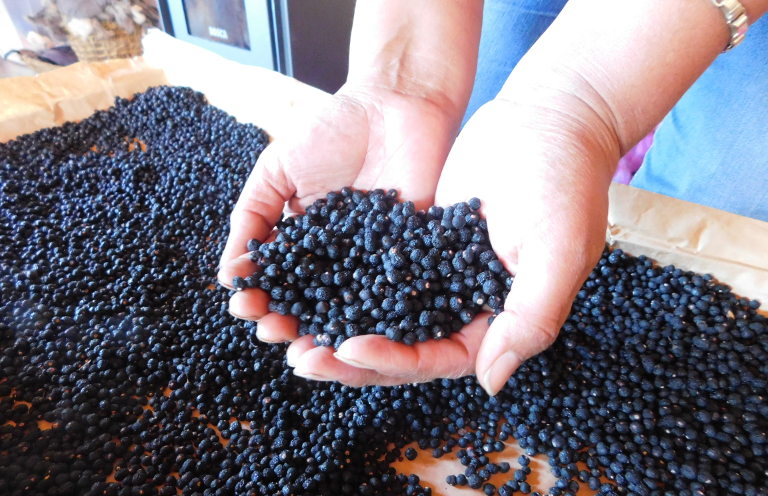
© Budi Anumka. Used with permission
Resuming regenerative economies
Through years of deep learning as an action research collective, we have come to recognize that the so-called “nature-based” solutions that could save Lake Budi and its mega diverse wetlands, and thereby preserve the biocultural heritage of the next generations of Mapuche-Lafkenche, are also emerging from the communities themselves as they regain control of their regenerative economies. These nature-based solutions are similar to other intertwined dimensions that we refer to as “community economies.”
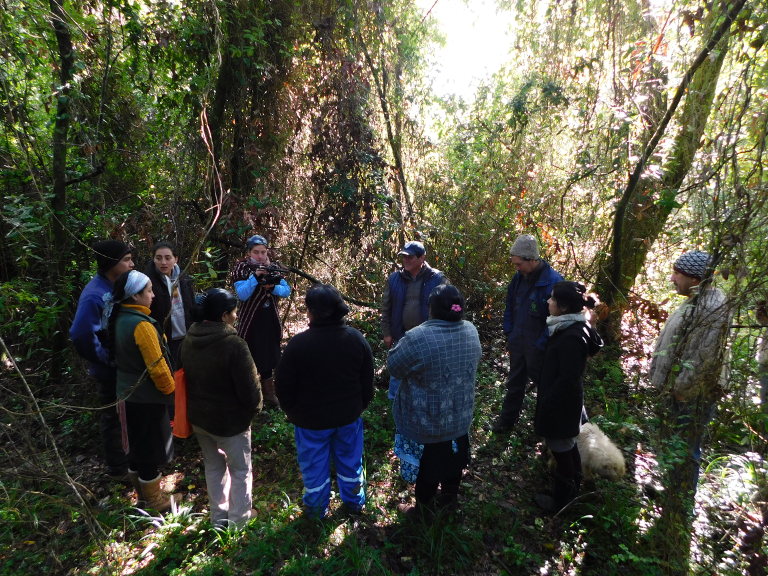
© Budi Anumka. Used with permission
We have also learned that the challenge is not simply to “return” to a previous condition, but to appropriate new tools to “retake” economic, environmental, cultural and political autonomy whenever they were taken away by colonization and post-colonialism. For example, resuming or revitalizing in the last two decades the ancient art of building and inhabiting the ruka or traditional long-house has meant for the families of the Llaguepulli lof to re-contextualize and revalue these spaces as complementary places to conventional construction, where community encounters, family gatherings, and cultural activities and ceremonies take place. Thus, after some decades in disuse, these nesting houses made with fibers obtained from nearby wetlands and with a bonfire at their core, once again express Mapuche-Lafkenche communal vitality and the sacredness of their intimate, daily relationship with water and the biodiversity of the surrounding wetlands.
Save the Budi: Budi Anumka and its allies come in
Budi Anumka (www.budi-anumka.org) is a diverse group of like-minded Mapuche professionals, thinkers, and activists, residing in the southern territories of Lake Budi, embedded in extended families that are woven across the length and breadth of territorial communities or lof, and ceremonial ensemblages or rewe. Collectively, the lof of Llaguepulli, Allipen, and Malalhue-Chanko are determining concrete actions to advance towards economic self-management and environmental regeneration of their territory, as their ancestors may have dreamed.
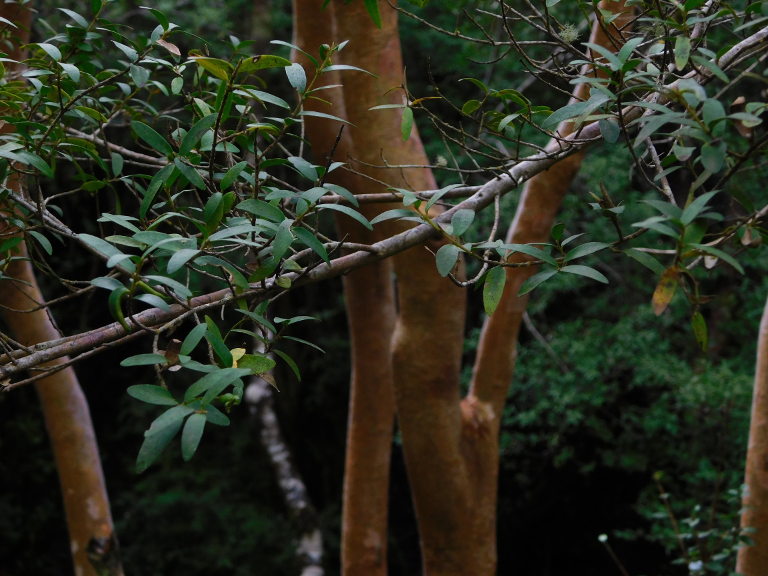
© Budi Anumka. Used with permission
Budi Anumka is a recently formed non-profit organization, formalized in late 2019 just before the pandemic. The intergenerational leadership, actions, agreements and tools that embody it, however, have been organically formed through years of interdisciplinary dialogue of knowledge. Since 2015, Budi Anumka — known earlier as the Network of Nurseries — has been involving Mapuche custodians and territorial authorities in a horizontal dialogue with researchers and scientists that is resulting in the co-design of innovative solutions and replicable models. In addition, a strong community of allies who adhere to the principles of self-determination and conservation of an irreplaceable biocultural heritage is developing around this Mapuche-led regenerative initiative.
As the following examples show, Budi Anumka is not just about promoting “environmental awareness”, but about creatively combining old and new tools to reactivate ‘blue’ regenerative economies capable of sustaining intricate restorative relationships between the people, the wetland, and the itrofillmonguen or biocultural heritage they both share.
- Native Agroforestry: Beginning in 2014, the principles and techniques of regenerative agroforestry have been adopted rapidly and enthusiastically by more and more families in the territory. First, through a small and rustic educational nursery in the community school, which served to house and care for the first seedlings of native species (anumka) by Mapuche-Lafkenche children themselves. Later, the children take them and plant them at their home, and now they observe them becoming majestic trees of lingue (Persea lingue), foye or canelo (Drimys winteri) and tüke or olivillo (Aextoxicon punctatum).
Among the twenty different species propagated today by the three community nurseries there are also some smaller shrubs. The shrubs may be small, but they are not minor in terms of their biocultural value, such as the üngi or murtilla (Ugni molinae) and the maqui or külon (Aristotelia chilensis). They have once again given families abundant harvests of fruits, leaves and medicinal stems, key in Mapuche preventive medicine or Lawen due to their exceptionally rich load of vitamins and antioxidants.
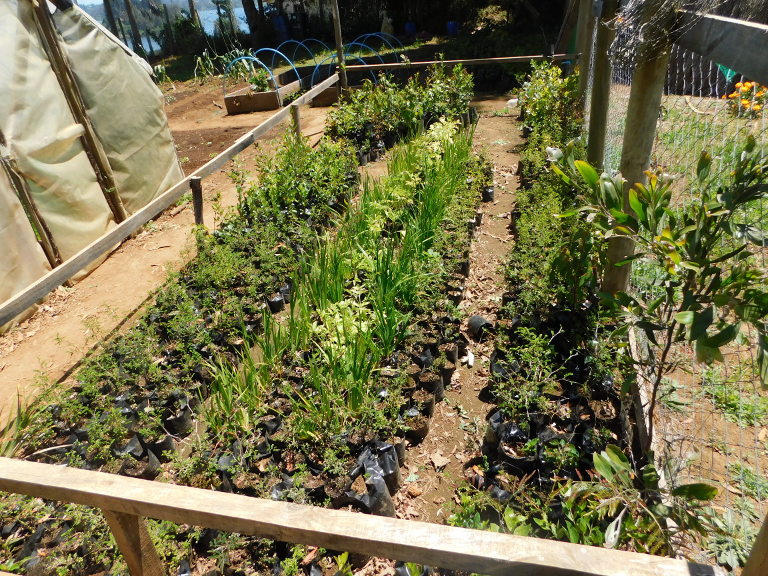
© Budi Anumka. Used with permission
Thus, the propagation of native plants in community nurseries and from there to small family plots has become part of a joyful, communal and daily effort to regain an ancestral intimate relationship with native species, and at the same time, as an effective mechanism for regenerative reinvestment in small family farms and the projection of sustainable regenerative economies over time.
- Blue regenerative economies: The international community created the “blue” label to promote sustainable livelihoods in the seas and coastal areas, but it also serves, from the grassroots perspective, to envision technologies and entities collaboratively designed in order to retake economies that put water and life in the center, an ancestral value of the Mapuche-Lafkenche people. Since 2016, local Lafkenche farmers have re-appropriated the practice of organic fertilizing by incorporating seaweed, a local input produced by neighboring coastal communities, but now using up-to-date techniques such as composting and foliar teas.
Curiously, once forgotten, the use of algae such as kollof or cochayuyo (Durvillaea antarctica) as a natural pesticide, fertilizer and biostimulant, is effectively replacing expensive and often toxic chemical inputs, induced by state agencies for decades. In this sense, it has proven to be a useful tool for more and more families who choose to cultivate healthy and nutritious gardens while protecting coastal soils, waters and wetlands, and their biodiversity, from further degradation. The practice also strengthens the community’s age-old exchange relationships with neighboring Lafkenche communities on the Pacific coast, as can be seen in the video “Strengthening Our Ancestral Practices”. (https://www.youtube.com/watch?v=NA-NRzdkLxM)
- Resistance to drought and global warming by collecting rainwater and restoring watersheds: What started as a concern by one of the leading Lafkenche families to capture rain to irrigate young trees during increasingly dry summers became a regional initiative for communities to collect rainwater for their gardens, tree-nurseries and restoration areas. Infiltration curves, rainwater collection and storage systems have been installed on the roofs of dozens of rural homes to cope with drought and an increasingly unstable climate. At the same time, using plants from the nurseries, strategic micro-basins that house threatened Lafkenche biocultural heritage are being restored, linked to sacred springs and medicinal plants present in the wetlands and in the remnants of riparian forests.
- Tools to create a community of allies: Technology can be of great help when it comes to convening the necessary collaboration to meet the goals and priorities of Native Peoples and their territories. With the support of long-term allies such as MAPLE Microdevelopment (a non-profit organization with headquarters in Oregon, United States, and present in Chile since 2013 [MAPLE Microdesarrollo Chile]), the communities are strengthening collaborative networks by incorporating allies and specialists nationally and globally. These include the Indigenous Peoples Program of the Faculty of Physical Sciences and Mathematics at the University of Chile; the International Consortium of Life Territories (TICCA), and other First Nations worldwide, such as the T’sou-ke First Nation of the Coast Salish Peoples of Vancouver Island, British Columbia, who are pioneering indigenous regenerative economies.
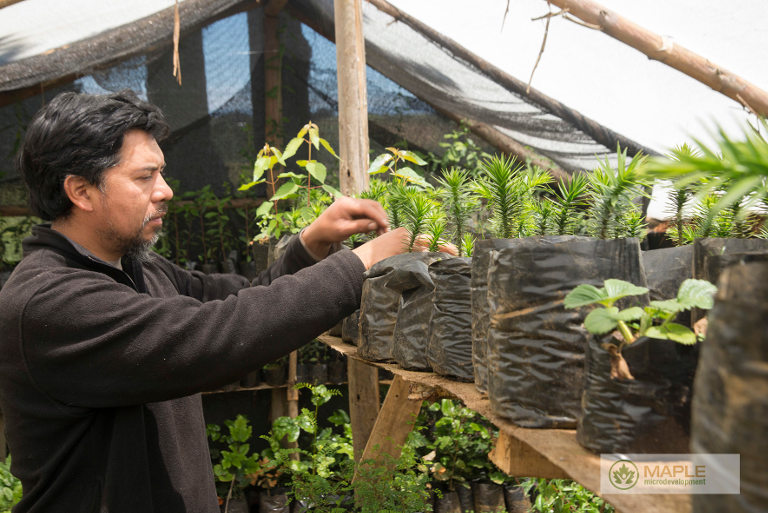
© Budi Anumka. Used with permission
At the end of 2020, a campaign for the “restoration in community” of the Budi Wetland was launched together with the collaborative financing platform PicParks.com, which uses digital and multimedia maps to invite supporters and allies to become part of the creation of biocultural corridors in sensitive and biodiverse areas in the contours and tributaries of the Budi Wetland, which are being prioritized, co-designed and supported by the Lafkenche families of the participating communities. We hope that, through this platform, Budi Anumka will continue to bring together like-minded people around their community-led regenerative initiatives, and promote community-to-community partnerships.
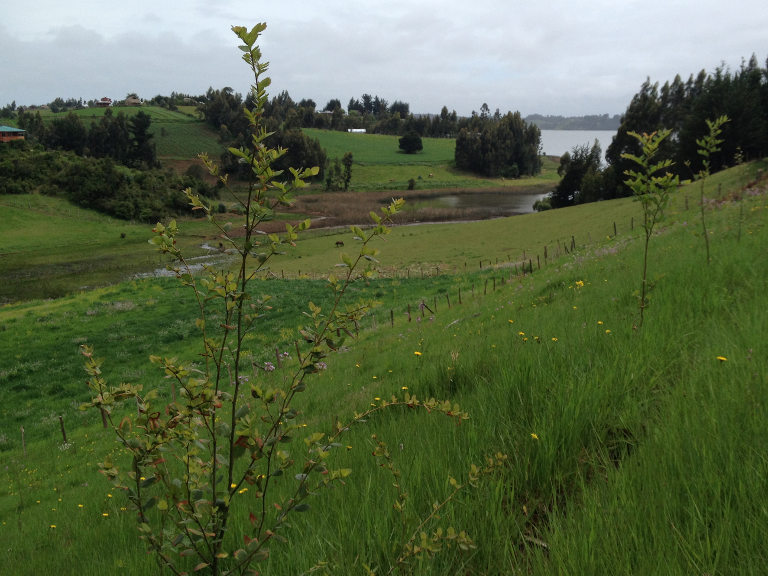
© Budi Anumka. Used with permission
Present and future challenges
With the support of allies and collaborators, a team led by Lafkenche agroecologist and one of the initiators of Budi Anumka, Fernando Quilaqueo Calfuqueo, began in 2020 — in the midst of the pandemic — to design and implement in stages the first biocultural corridor of Budi in conjunction with six initial families, supported by young leaders from Budi Anumka. In addition, today, the modular network of tree nurseries now contains a large number and diversity of plants traditionally used for food, fiber and herbal medicines. These, in turn, are being harvested in a sustainable way to be converted, within the territory itself, into products with added environmental and cultural value, such as nuts, oils, cosmetics and biodegradable bags, by more and more young people, women and artisans, who have proved to be key players in co-leading blue regenerative economies. The participating communities have appropriated innovative models and cutting-edge technologies in order to retake and revitalize the traditional knowledge and biocultural heritage of the ancestral territory of Lake Budi. Or as clearly stated on the Budi Anumka website, “to continue the permanent defense of the Itrofillmonguen or biocultural heritage of our territory, inheritance of our ancestors and fundamental pillar of our Az monguen or Mapuche way of life, that our grandparents defended, administered and bequeathed to us, and thus we do it for the new generations.”
We invite you to visit www.budi-anumka.org and join the Budi restoration community!
*****
References:
Aillapán, L. (2003). Üñümche, Hombre Pájaro. Santiago: Pehuén.
Gibson-Graham, J. K., Cameron, J., & Healy, S. (2013). Take back the economy: An ethical guide for transforming our communities. U of Minnesota Press.
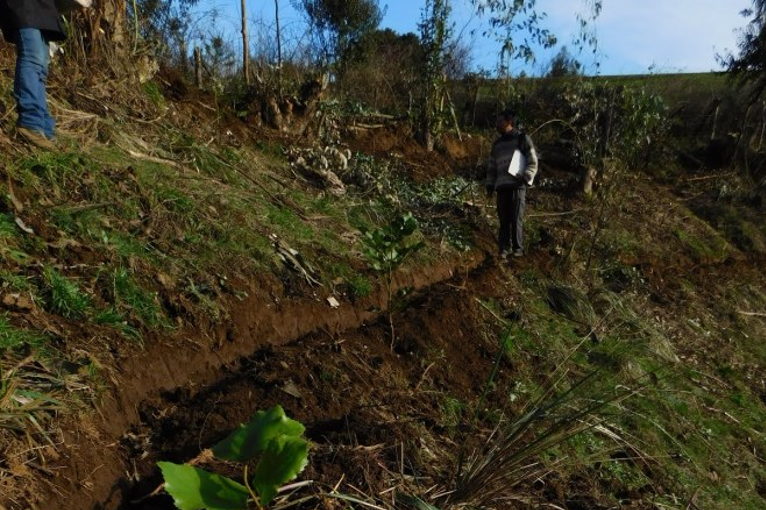
© Budi Anumka. Used with permission
*****
*About the authors:
Alison Guzman has a B.A. International Studies and a M.A. in Ethics, Peace and Global Affairs (with a concentration in Indigenous Rights and Social Justice) at the School of International Service at The American University, and a Professional Certificate of Museum Studies at the Institute of American Indian Arts internationalist.
Ignacio Krell has a professional degree of Sociologist from the University of Chile and a Masters in Environmental Studies from the University of Oregon.
Guzman and Krell are both researchers associated with the Institute of Community Economies and Co-Directors of the NGO MAPLE Microdesarrollo Chile. As partners in the action-research-collective, they are developing collaborative approaches to document, systematize and share knowledge generated in processes of indigenous institutional co-design of community economies, sustainable community-to-community philanthropy, and community-led strategies for regenerating ecologies, biocultural heritages, and local economies.
Guzman has served as co-director of this team based in Wallmapu (Mapuche Ancestral lands) since 2013, exploring decolonizing methodologies, where indigenous local knowledge and local wisdom-based systems are prioritized as an integral part of co-designing community asset-management tools. She also manages our program´s international collaborative efforts while developing sustainable community-to-community philanthropy. Current research interests include global native-led methodologies for cultural management and cultural spaces/museums in the digital age, methods for identifying and measuring biocultural indicators and heritage, the role of cultural spaces and indigenous-led museums, and cataloguing and cultural management methodologies for the development of indigenous cultural heritage within the context of indigenous commons.
Krell began collaborating with Mapuche communities in 1999, combining research and practice in different contexts: from activism against the flooding of ancestral lands by mega-dams in the Biobío, to community-based ecotourism, to community-led design of financial and environmental self-management tools. Current research focuses include agroecological transition/scaling-up as a social praxis, institutional syncretism and co-design as a decolonizing methodology, tourism entrepreneurship in biocultural territories, community/alternative finances as commoning, and indigenous environmental history and knowledge.
Publications
Guzman, A., Krell, I., (2017) Bringing Back Balance: Women Revitalizing the Mapuche Economy. Cultural Survival Quarterly Magazine. December 2017
Available at: https://www.culturalsurvival.org/publications/cultural-survival-quarterly/bringing-back-balance-women-revitalizing-mapuche-economy
Guzman, A., Krell, I., (2020) Impact Evaluation Report: Mutual Support Group-Rekvlvwun 2014-2018. MAPLE Microdevelopment, Villarrica, Chile. Available at: https://www.communityeconomies.org/sites/default/files/2021-02/Maple%20Chile%20-%20E.I.%20GAM%20English%2017.10.20%20%281%29.pdf
Guzman, A., Krell, I., (2021) Territorio Ancestral Lago Budi: oportunidad colaborativa para revitalizar una economía regenerativa azul. Revista Ladera Sur, Santiago, Chile. Available at: https://laderasur.com/articulo/territorio-ancestral-lago-budi-oportunidad-colaborativa-para-revitalizar-una-economia-regenerativa-azul/




